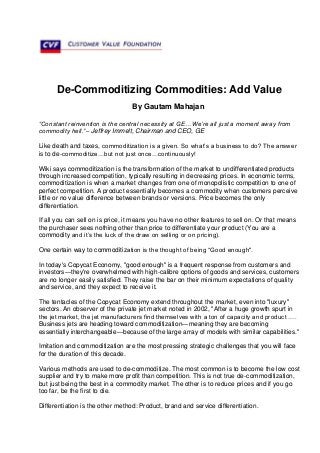
Decommoditising Commodities: Add Value
- 1. De-Commoditizing Commodities: Add Value By Gautam Mahajan “Constant reinvention is the central necessity at GE…We’re all just a moment away from commodity hell.”– Jeffrey Immelt, Chairman and CEO, GE Like death and taxes, commoditization is a given. So what’s a business to do? The answer is to de-commoditize…but not just once…continuously! Wiki says commoditization is the transformation of the market to undifferentiated products through increased competition, typically resulting in decreasing prices. In economic terms, commoditization is when a market changes from one of monopolistic competition to one of perfect competition. A product essentially becomes a commodity when customers perceive little or no value difference between brands or versions. Price becomes the only differentiation. If all you can sell on is price, it means you have no other features to sell on. Or that means the purchaser sees nothing other than price to differentiate your product (You are a commodity and it’s the luck of the draw on selling or on pricing). One certain way to commoditization is the thought of being “Good enough". In today's Copycat Economy, "good enough" is a frequent response from customers and investors—they're overwhelmed with high-calibre options of goods and services, customers are no longer easily satisfied. They raise the bar on their minimum expectations of quality and service, and they expect to receive it. The tentacles of the Copycat Economy extend throughout the market, even into "luxury" sectors. An observer of the private jet market noted in 2002, "After a huge growth spurt in the jet market, the jet manufacturers find themselves with a ton of capacity and product …. Business jets are heading toward commoditization—meaning they are becoming essentially interchangeable—because of the large array of models with similar capabilities." Imitation and commoditization are the most pressing strategic challenges that you will face for the duration of this decade. Various methods are used to de-commoditize. The most common is to become the low cost supplier and try to make more profit than competition. This is not true de-commoditization, but just being the best in a commodity market. The other is to reduce prices and if you go too far, be the first to die. Differentiation is the other method: Product, brand and service differentiation.
- 2. Innovate, bundle (add a service to it or add another product), and segment are common ways that people use. The real differentiator is value differentiation Product differentiation is the most popular. This certainly helps, but the advantage is short lived as competition comes up with me too products. For example, the product 7UP was a commodity for many years. Recognizing the trend for customers to want healthier drink options, 7UP de-commoditized their soda by taking out all the artificial flavours and ingredients and making their product natural. After they launched their new “natural” campaign, sales of 7UP increased. Segmentation of the market is another method. Natural gas producers were able to segment during an oversupply situation. They used a trained Customer Value team for understanding the “Day in the Life of a Customer” and were able to add value to certain segments leading to a 40% increase in profits. Water is a commodity. The price of water and perhaps level the demand will vary when water is scarce, such as in the summer time. You could play that game (wait for scarcity). Water is water… until you put it in a bottle. Once you put water in a bottle, you can charge for it. You can then put the water in a fancier bottle and charge some more. You can also add some vitamins to it, give it a fancy name, and charge even more. Now you’re taken a commodity and you’ve de-commoditized it. And then you brand to keep your price and market going. But the best way to differentiate is to add Customer Value and this is with better service, customer experience and customer relationship. Marketing Professor John Quelch of the Harvard Business School says the most overlooked investment a marketer can make in advance of inevitable commoditization is a customer relationship. You have to create value for the customer. First understand what a customer values and deliver it and keep track of his changing value needs. Look even at "Uncharted value," Professor Oren Harari said. And companies looking at uncharted value are not aspiring to satisfy customers. "Satisfaction is a commodity response to a commodity transaction," Harari said. What you want is the 'wow!' approach and to increase value. We have helped clients in businesses as commoditized and diverse as fertilisers, pest control service and power distribution to de-commoditize by providing an emotional connect to the brand and by creating value. We have found that Values create value and help de- commoditize businesses. We have helped them differentiate themselves and look at next practices and superiority. Make your employees your internal partners, who will raise the bar and make customer interactions moments of truth. And the only way out of the Commodity hell is to add value. So learn to measure what a customer values and deliver more of it than competition. And value can be product, service, brand image, and customer relationship. Or you can play the price game and die.
- 3. Remember, when you start turning your products into commodities, you start treating your customers like commodities. Gautam Mahajan is a thought leader in Creating Value and de-commoditizing. He can be reached at mahajan@customervaluefoundation.com Call at (+91) 9971288580 Gautam Mahajan, President-Customer Value Foundation M: +91 9810060368 Tel: 11-26831226, Fax: 11-26929055 email: mahajan@customervaluefoundation.com website: http://www.customervaluefoundation.com
